Crafting Your Career Change Cover Letter
Changing careers can be an exciting yet challenging endeavor. Your cover letter is your first impression, a crucial document that tells your story and convinces a potential employer that you’re the right fit, even if your past experience seems unrelated. Unlike a resume, a cover letter allows you to explain your motivations, connect your previous experiences to the new role, and demonstrate your enthusiasm. This guide provides a comprehensive overview of how to write a career change cover letter that highlights your strengths and makes a compelling case for your candidacy. By following these steps, you can create a cover letter that not only grabs the hiring manager’s attention but also increases your chances of landing an interview.
Understanding the Purpose
The primary purpose of a career change cover letter is to bridge the gap between your past experiences and the new role you’re seeking. It serves as a narrative, explaining why you’re making a career change, what skills you bring to the table, and why you’re interested in this specific opportunity. It’s an opportunity to address any perceived gaps in your experience and demonstrate how your skills are transferrable. The cover letter is designed to offer context to the resume, filling in any blanks and offering a more nuanced picture of your suitability for the role. Consider it a tool to communicate your story effectively and persuade the hiring manager of your potential.
Highlighting Transferable Skills
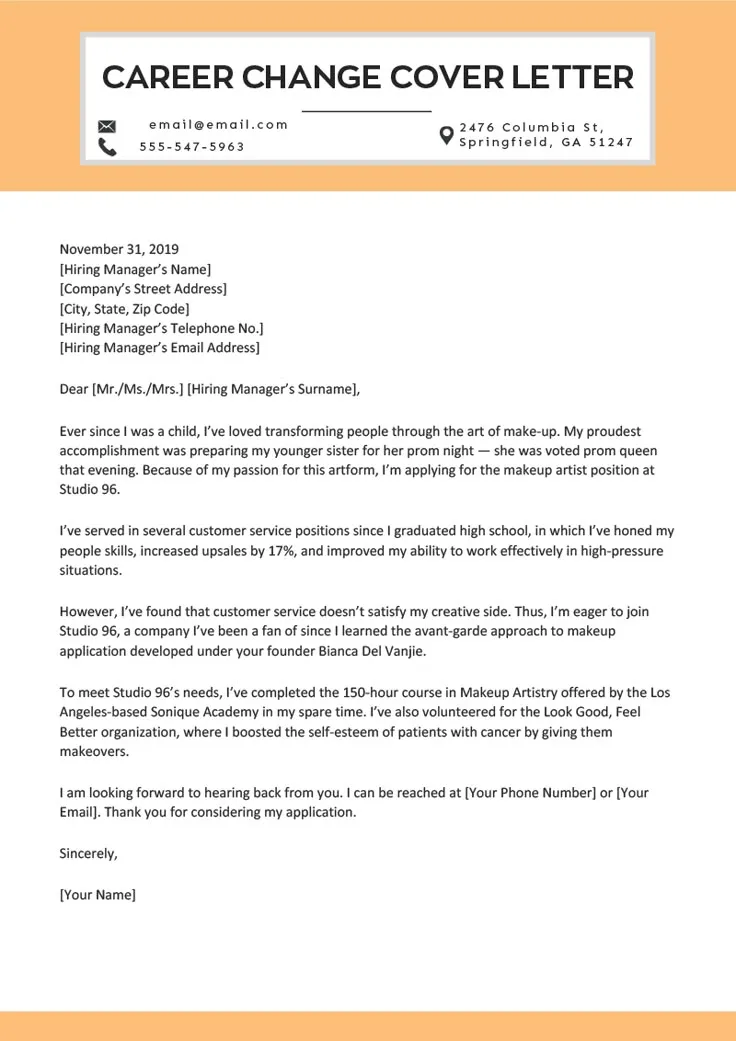
One of the most critical aspects of a career change cover letter is highlighting your transferable skills. These are the skills you’ve developed in previous roles or experiences that are relevant to the new position, even if the job titles or industries are different. Identify your core competencies, such as communication, problem-solving, leadership, project management, or customer service, and demonstrate how you’ve used them effectively in the past. Use concrete examples to showcase these skills, providing evidence of your abilities. This helps the employer see how your experience can benefit their organization. For instance, if you’re moving from teaching to project management, highlight your organizational skills, ability to manage deadlines, and ability to communicate with diverse groups, showcasing your versatility.
Addressing the Career Change
Your cover letter should openly address your career change. Briefly explain your reasons for making the switch. Be positive and focus on the future, not on what you’re leaving behind. Frame your decision in terms of your goals and what you hope to achieve in your new role. Show enthusiasm for the new opportunity. This helps demonstrate your commitment. For example, you might say, “My passion for sustainable energy, combined with my project management experience, has led me to seek this role at GreenTech.” Avoid any negativity about your previous roles or employers. Instead, emphasize your proactive approach to your career and your excitement for the new position.
Structuring Your Cover Letter
The Header Section
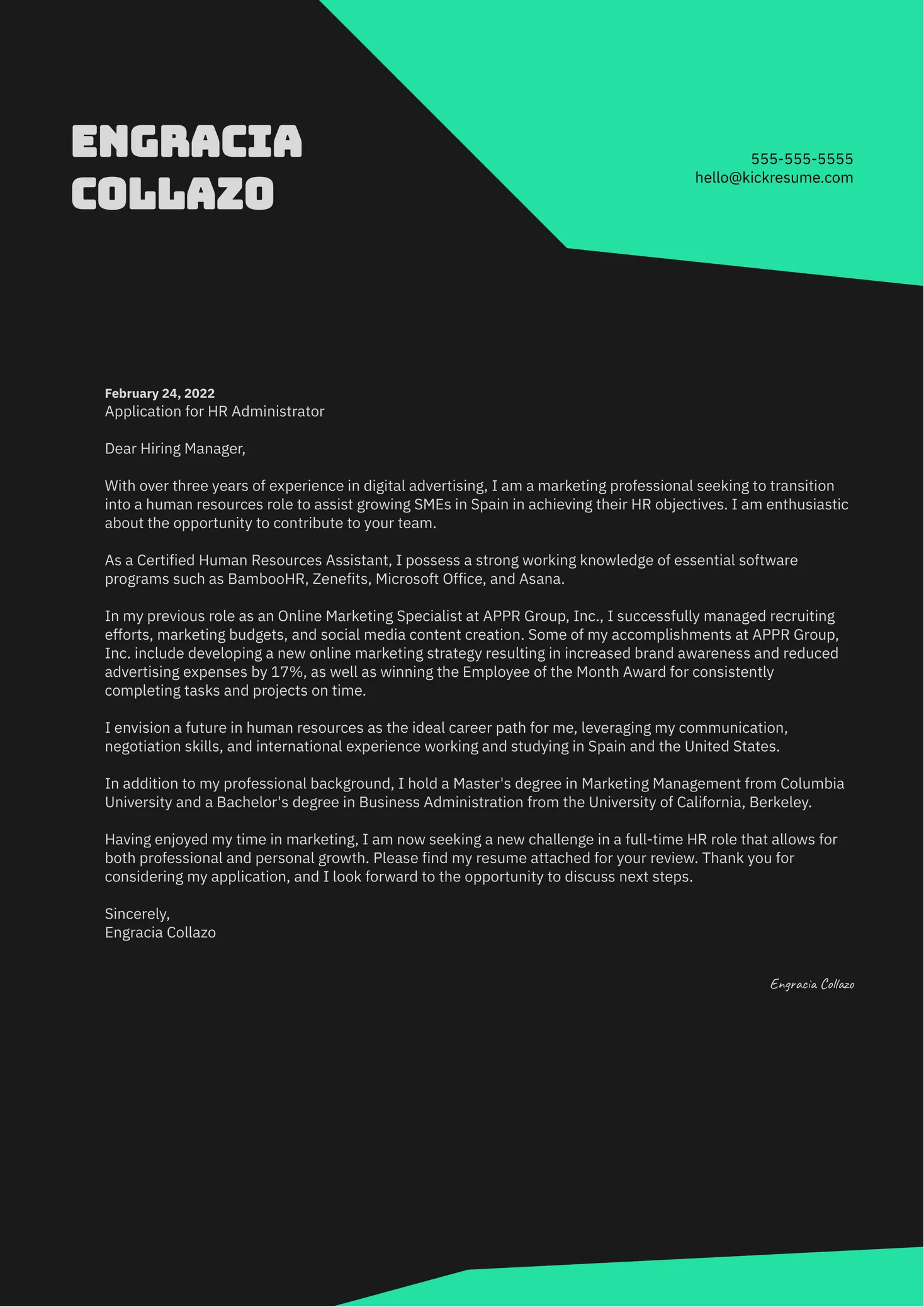
Start your cover letter with a professional header. Include your name, address, phone number, and email. If you are applying through a specific job portal, make sure your contact details match your profile. Below your contact information, add the date and the hiring manager’s name (if you know it), the company name, and the company’s address. Addressing the hiring manager by name is a great way to show that you’ve taken the time to research the company and the role. This personal touch can make a good first impression.
The Opening Paragraph
Your opening paragraph is your opportunity to grab the reader’s attention. Clearly state the position you’re applying for and how you learned about the opportunity. Briefly mention why you’re interested in the role and the company. This section sets the tone for the rest of the letter, so make it engaging and concise. Consider starting with a strong statement that highlights a key skill or achievement. For example, “As a highly organized project manager with a passion for renewable energy, I am excited to apply for the Project Manager position at Solar Solutions, as advertised on LinkedIn.”
Body Paragraphs
The body paragraphs are where you provide the details that will support your case. In this section, elaborate on your transferable skills and experiences, providing specific examples of how you’ve used them. Tailor your examples to the specific requirements of the job description, demonstrating that you understand what the employer is looking for. Describe your achievements in previous roles. Use the STAR method (Situation, Task, Action, Result) to structure your examples. This method provides context, explains the actions you took, and quantifies the results you achieved. Address any gaps in your experience proactively, and show how you are planning to overcome them. It might be taking courses, attending seminars or shadowing someone in the industry.
Closing Paragraph
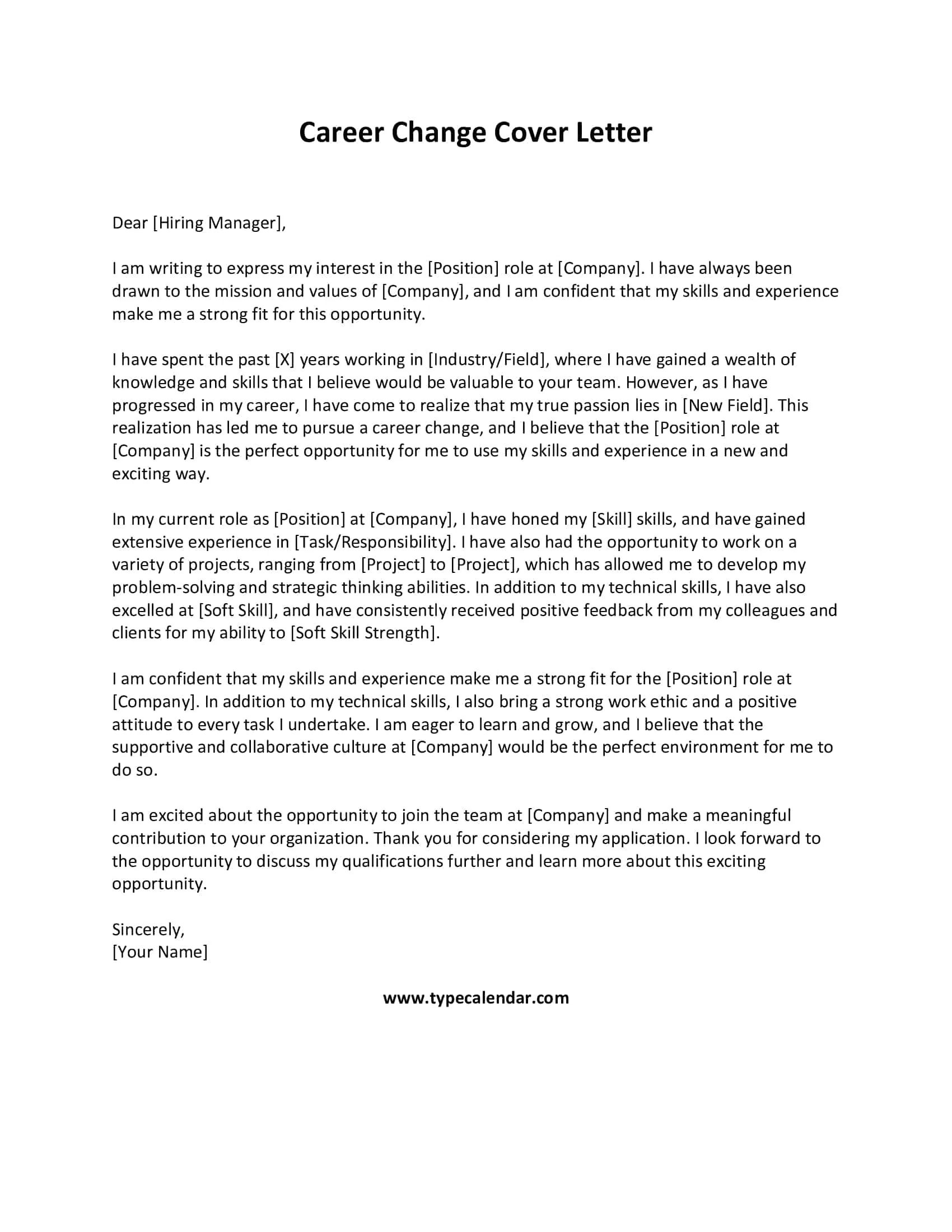
Conclude your cover letter with a strong closing paragraph. Reiterate your interest in the position and express your enthusiasm for the opportunity. Thank the hiring manager for their time and consideration. Include a call to action, such as stating that you are available for an interview and eager to discuss how you can contribute to the company. Keep it concise and professional. Make sure your contact details are included so it is easy for them to reach you.
Key Elements to Include
Showcasing Your Enthusiasm
Demonstrate your genuine interest in the role and the company. Research the company’s values, mission, and recent projects. Mention specific aspects of the company or the role that excite you. Show that you’re not just looking for any job but are specifically interested in this opportunity. Your enthusiasm will show your commitment to the company and the position. Your passion and excitement can significantly influence the hiring manager’s perception of your potential, showcasing your genuine interest in the role.
Quantifying Your Achievements

Use numbers and data to highlight your achievements whenever possible. Quantify your accomplishments to provide concrete evidence of your skills and impact. Instead of saying, “Managed projects successfully,” say, “Managed projects on time and under budget, resulting in a 15% increase in efficiency.” This makes your achievements more compelling and easier for the hiring manager to understand. Quantifiable achievements make your skills clear, providing specific examples of your impact and showing the value you bring to the company.
Tailoring to the Specific Job
Customize each cover letter to the specific job and company. Avoid sending generic cover letters, which can easily be spotted by recruiters. Carefully review the job description, and identify the key requirements and skills that the employer is looking for. Address each requirement directly in your letter, providing examples of how your skills and experience align with those requirements. Research the company culture and values, and tailor your language to match. This level of personalization demonstrates that you have done your homework, and that you’re genuinely interested in the role and the company, making you stand out among a crowd of applicants. This focus significantly boosts your chances of getting an interview.
Common Mistakes to Avoid
Generic Letters
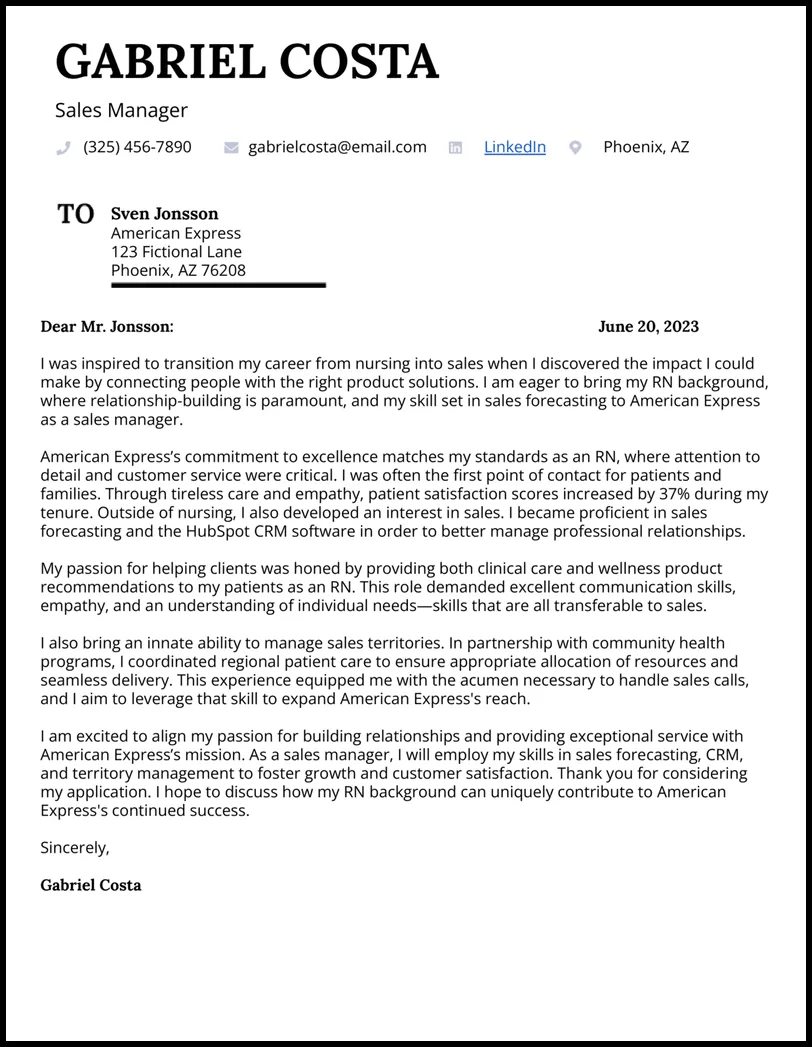
Sending a generic cover letter is a major mistake. Generic letters show a lack of effort and a lack of genuine interest in the specific role or company. Customize each cover letter to the specific job. Reference the company’s values, the job responsibilities, and how your skills align with their needs. Address the hiring manager by name, when possible, as it demonstrates that you have taken the time to research the company and the role. Personalized cover letters show initiative and make a positive impression, setting you apart from other applicants.
Focusing on the Past
While it’s important to provide context, don’t dwell on your past experiences. Focus on how your skills and experiences relate to the new role. Instead of just listing your past responsibilities, emphasize the skills you’ve developed and how they’re transferrable to the new position. Highlight your accomplishments and how they can benefit the new employer. Show your enthusiasm and discuss your plans to contribute to the company’s goals. Keep the focus on the future, emphasizing your motivation and how you plan to succeed in your new role.
Ignoring the Employer’s Needs
Make sure your cover letter directly addresses the employer’s needs. The job description is a roadmap, so refer to it and address each point in the job description. Show that you understand the requirements of the role and explain how your skills and experiences make you a great fit. Focus on what the employer is looking for. Show that you have researched the company. Demonstrate that you understand their goals and how you can help them achieve them. This shows your commitment and makes it clear that you are interested in the role, not just any job. The hiring manager will be more likely to call you for an interview.
Proofreading and Editing
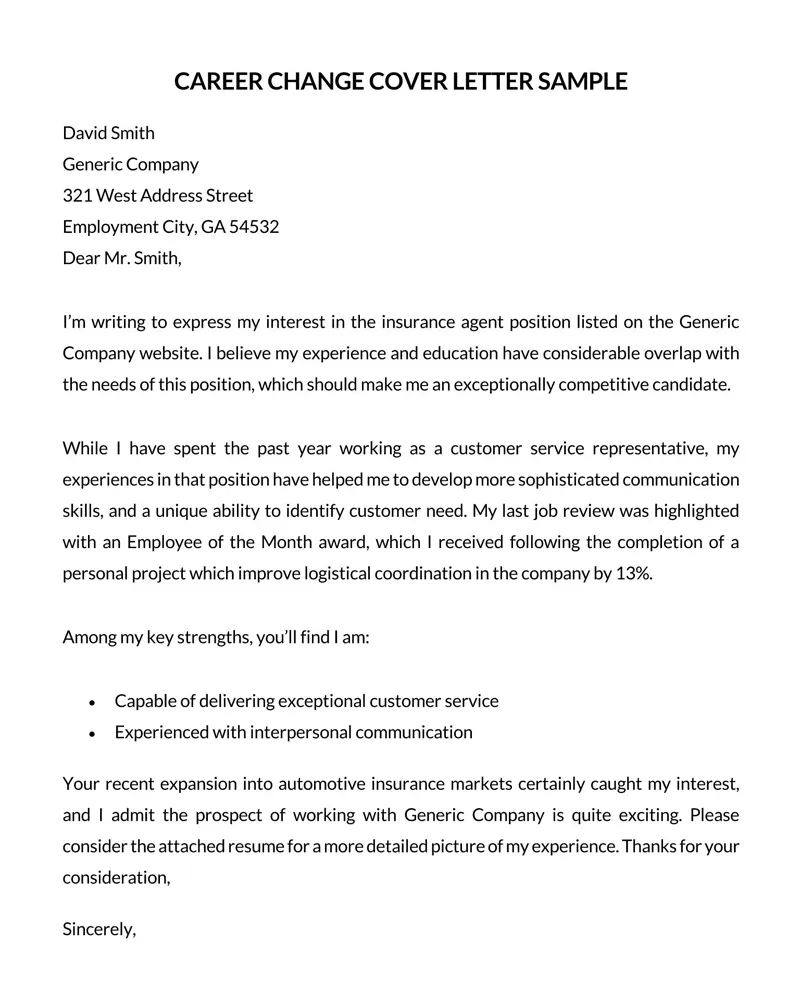
Always proofread and edit your cover letter carefully. Errors in grammar, spelling, and punctuation can undermine your credibility and make you look unprofessional. Review your letter multiple times, and ideally, have someone else proofread it for you. Ensure that your letter flows well, and that your message is clear and concise. Make sure that your formatting is consistent. Proofreading demonstrates attention to detail and professionalism, showing the hiring manager that you care about your application. A well-written, error-free cover letter greatly increases your chances of getting an interview.
Writing a compelling cover letter for a career change requires careful planning, clear communication, and a focus on your transferable skills. By understanding the purpose of the cover letter, highlighting your achievements, and tailoring your letter to the specific job, you can increase your chances of landing an interview and making a successful career transition. Remember to showcase your enthusiasm, quantify your achievements, and avoid common mistakes. Good luck with your job search!
